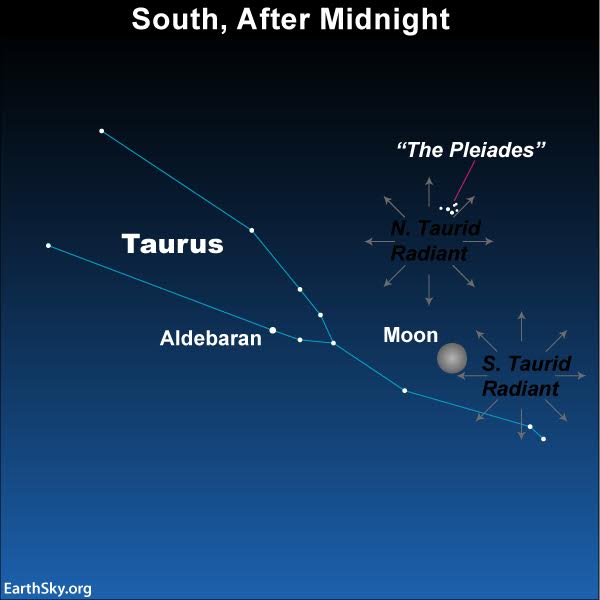
Claire L. Shickora at Delight’s Hot Springs Resort in Tecopa, California wrote: “The Pleiades was outstanding, even with the local light pollution!”
Here’s a beautiful shot of the Pleiades star cluster – also known as the Seven Sisters – ascending in the eastern sky each evening now. See the tiny cluster that looks like a dipper, with its handle pointing downward? That’s it.
This little cluster marks the approximate radiant point of the South and North Taurid meteor showers, both of which are long-lasting showers, going on now. The Pleiades is part of the constellation Taurus the Bull, and the meteors take their name from this constellation. Taurus is pretty easy to spot, but the Pleiades is very easy. Just remember it’s a tiny cluster – dipper-shaped – ascending in the eastern sky throughout the evening hours now.
Thanks for the photo, Claire L. Shickora!
Read more: Pleiades cluster, aka Seven Sisters
Read more: Tips for watching Taurid meteors

If you trace the Taurid meteors backward, you’ll see that these meteors appear to come from the constellation Taurus the Bull, and its famous Pleiades star cluster. Read more.
Bottom line: A November, 2018, photo of the Pleiades star cluster, which marks the approximate radiant point for the Taurid meteor shower.
from EarthSky https://ift.tt/2QuCV7y

Claire L. Shickora at Delight’s Hot Springs Resort in Tecopa, California wrote: “The Pleiades was outstanding, even with the local light pollution!”
Here’s a beautiful shot of the Pleiades star cluster – also known as the Seven Sisters – ascending in the eastern sky each evening now. See the tiny cluster that looks like a dipper, with its handle pointing downward? That’s it.
This little cluster marks the approximate radiant point of the South and North Taurid meteor showers, both of which are long-lasting showers, going on now. The Pleiades is part of the constellation Taurus the Bull, and the meteors take their name from this constellation. Taurus is pretty easy to spot, but the Pleiades is very easy. Just remember it’s a tiny cluster – dipper-shaped – ascending in the eastern sky throughout the evening hours now.
Thanks for the photo, Claire L. Shickora!
Read more: Pleiades cluster, aka Seven Sisters
Read more: Tips for watching Taurid meteors

If you trace the Taurid meteors backward, you’ll see that these meteors appear to come from the constellation Taurus the Bull, and its famous Pleiades star cluster. Read more.
Bottom line: A November, 2018, photo of the Pleiades star cluster, which marks the approximate radiant point for the Taurid meteor shower.
from EarthSky https://ift.tt/2QuCV7y

Aucun commentaire:
Enregistrer un commentaire